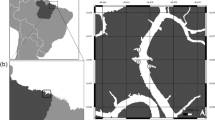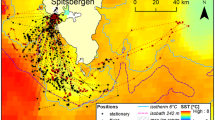Summary
Great crested grebes Podiceps cristatus only foraged for an hour or two during dawn and again during dusk on Lake IJsselmeer in August-September. During this time of the year the adult birds are in wing moult and temporarily unable to fly. The food of grebes consisted almost exclusively of smelt Osmerus eperlanus, the most numberous pelagic fish. Simultaneous sonar registrations and trawl net fishing showed that smelt moved to the water surface during the twilight periods. During day and night they were concentrated near the bottom. We argue that grebes have the best foraging opportunities during twilight when much of their prey is near the surface, where light intensities allow the fish to be detected and captured. When the smelt are in the upper water layers the distance to the covered to get the prey (i.e. diving time and cost) is also least.
Similar content being viewed by others
References
Argyle RL (1982) Alewives and rainbow smelt in Lake Huron: midwater and bottom aggregations and estimates of standing stocks. Trans am Fish Soc 111:267–285
Berger C (1987) Habitat en ecologie van Oscillatoria agardhii Gomart. Thesis Rijksuniversiteit, Groningen
Blaxter JHS (1966) The effect of light intensity on the feeding ecology of herring. In: Bainbridge R, Evans GC, Rackham O (eds) Light as an ecological factor. Brit Ecol Soc Symp 6, London, pp 393–409
Bohl E (1980) Diel pattern of pelagic distribution and feeding in planktivorous fish. Oecologia (Berlin) 44:368–375
Croxall JP, Everson I, Kooyman GL, Ricketts C, Davis RW (1985) Fur seal diving behaviour in relation to vertical distribution of krill. J Anim Ecol 54:1–8
Daan S (1981) Adaptive daily strategies in behavior. In: Aschoff J (ed) Handbook of behavioral neurophysiology, Vol 4, Biological rhythms. Plenum Press, New York, pp 275–297
Enright JT, Hammer, WM (1967) Vertical diurnal migration and endogenous rhythmicity. Science 157:937–941
Forbes ST, Nakken O (eds) (1972) Manual of methods for fisheries resource survey and appraisal, Part 2: The use of acoustic instruments for fish detection and abundance estimation. FAO, Rome
Hamrin SF (1985) Vertical distribution and diel rhythm of different age classes of vendace, Coregonus albula, in thermally stratified lakes. Verh Internat Verein Limnol. 22:2554
Hanzák J (1952) The Great Crested Grebe, Podiceps c. cristatus (L.), its ecology and economic significance Sbornik Narod Mus Praze 8B:3–37
Harrisson TH Hollom PAD (1932) The Great Crested Grebe Enquiry, 1931 — Part 3. Brit Birds 26:142–155
Hobson ES (1968) Predatory behavior of some shore fishes in the Gulf of California. Res Rep US Fish Wildl Serv 73:1–92
Hutchinson GE (1967) A treatise on limnology, Vol. II. Introduction to lake biology and the limnoplankton. Wiley, New York
Lawrence GE (1950) The diving and feeding activity of the Western Grebe on the breeding grounds. Condor 52:3–16
Lythgoe JN (1979) The ecology of vision. Clarendon Press, Oxford
Mayr C (1966) Jahres- und Tageszeitliche Aspekte des Beutefangverhaltens von Haubentauchern (Podiceps cristatus L.). Thesis, Aachen
Metcalfe NB, Huntingford FA, Thorpe JE (1987) The influence of predation risk on the feeding motivation and foraging strategy of juvenile Atlantic salmon. Anim Behav 35:901–911
Narver DW (1970) Diel vertical movements and feeding of underyearling sockeye-salmon and the limnetic zooplankton in Babine lake. British Columbia. J Fish Res Bed, Canada 27:281–316
Neill SR St J, Cullen JM (1974) Experiments on whether schooling by their prey affects the hunting behaviour of cephalopod and fish predators. J Zool, London 172:549–569
Northcote TG, Rundberg H (1970) Spatial distribution of pelagic fishes in Lambarfjärden (Mälaren, Sweden) with particular reference to interaction between Coregonus albula and Osmerus eperlanus. Rep Inst Feshw Res Drottningholm 50:133–157
Piersma T (1987) Population turnover in groups of wing-moulting waterbirds: the use of a natural marker in Great Crested Grebes. Wildfowl 28:37–45
Piersma T (1988) Body size, nutrient reserves and diet of Rednecked and Slavonian Grebes (Podiceps grisegena and P. auritus) on Lake IJsselmeer, The Netherlands. Bird Study 35:13–24
Piersma T, Vlug JJ, Westhof JHP (1986) Twintig jaar ruiende futen Podiceps cristatus bij de Mokkebank, 1966–1985. Vanellus 34:27–37
Simmons KEL (1955) Studies on Great Crested Grebes. Avic Mag 61:93–102
Simmons KEL (1977) Further studies on Great Crested Grebes. 2. Maintenance activities and routine. Bristol Orn 10:175–196
Sjöberg K (1985) Foraging activity patterns in the goosander (Mergus merganser) and the red-breasted merganser (M. serrator) in relation to patterns of activity in their major prey species. Oecologia (Berlin) 67:35–39
Thorpe JE (ed) (1978) Rhythmic activity of fishes. Academic Press, London
Vuorinen I (1987) Vertical migration of Eurytemora (Crustacea, Copepoda): a compromise between the risks of predation and decreased fecundity. J Plankton Res 9:1037–1046
Zaret TM (1980) Predation and freshwater communities. Yale Univ Press, New Haven and London
Author information
Authors and Affiliations
Rights and permissions
About this article
Cite this article
Piersma, T., Lindeboom, R. & van Eerden, M.R. Foraging rhythm of great crested grebes Podiceps cristatus adjusted to diel variations in the vertical distribution of their prey Osmerus eperlanus in a shallow eutrophic lake in The Netherlands. Oecologia 76, 481–486 (1988). https://doi.org/10.1007/BF00397858
Received:
Issue Date:
DOI: https://doi.org/10.1007/BF00397858




